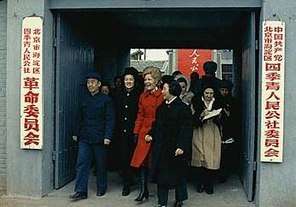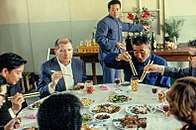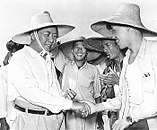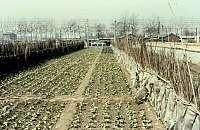People's commune

The people's commune (Chinese: 人民公社; pinyin: rénmín gōngshè) was the highest of three administrative levels in rural areas of the People's Republic of China during the period from 1958 to 1983 when they were replaced by townships. Communes, the largest collective units, were divided in turn into production brigades and production teams. The communes had governmental, political, and economic functions during the Cultural Revolution. The people's commune was commonly known for the collective activities within them, including labor and meal preparation, which allowed for workers to share local welfare. Though, this also caused the communities of people included in the people's communes to be struck harder by food shortages, and face longer hours than under individual labor.

History
The people's commune was established during the Great Leap Forward, when Mao Zedong had the goal of surpassing the United Kingdom and the United States in terms of steel production over a short period of time. Mao also wanted to mobilize peasants to undertake huge water projects during the winter slack seasons in order to improve agricultural productivity.
The People's commune was made official state policy in 1958 after Mao Zedong visited an unofficial commune in Henan. Mao's goal in creating the People's Communes was to collectivize China's agricultural and industrial economy.

Formation
In order to put this radical plan into action, Mao used the Anti-Rightist Movement to silence his political opponents so he faced virtually no opposition when he finally implemented the People's communes. Using various propaganda campaigns, Mao gained the initial support of the peasants.
The People's communes were formed in support of the Great Leap Forward campaign and remains an inseparable part of the campaign, as shown in the Three Red Banners propaganda poster.
Each commune was a combination of smaller farm collectives and consisted of 4,000–5,000 households. Larger communes could consist of up to 20,000 households.
Commune life
In the commune, everything was shared. Private kitchens became redundant, and everything in the private kitchen, such as tables, chairs, cooking utensils and pans were all contributed to the commune's kitchen. Private cooking was banned[1] and replaced by communal dining.
Everything originally owned by the households, private animals, stored grains and other food items were also contributed to the commune. They were put to different uses as assigned by the commune. All farming activities were to be centrally assigned by cadres every morning. Even money was outlawed in some places. Everybody in the commune were assigned jobs by their commune leaders.
The communes exercised management and control of all rural resources such as labor and land. Because of governmental control over resources and bad weather in 1958, 1959 and 1960 the Great Chinese Famine spread over the countryside, with much food being exported to urban areas.[2]
Despite the communes' shared work ethic and food distribution, problems could arise due to the shared nature of the community. For example, during a lull in agricultural production, the effects would be felt by the commune as a whole, contributing to longer hours and food shortages during times of low harvest or production. These problems though would attempt to be avoided through the use of fertilizers and food reserves.
Gallery
 Children eating at a nursery school in a people's commune
Children eating at a nursery school in a people's commune Hungarian journalist Ferenc Sarkadi Kovács at a people's commune
Hungarian journalist Ferenc Sarkadi Kovács at a people's commune A meal being eating during a state visit of Hungary to China inside a people's commune during meal hour.
A meal being eating during a state visit of Hungary to China inside a people's commune during meal hour. Mao Zedong shaking hands with a people's commune farmer
Mao Zedong shaking hands with a people's commune farmer An example of a people's commune collective farm
An example of a people's commune collective farm
See also
| Wikimedia Commons has media related to Chinese People's commune. |
References
![]()
Yang, Dali. Calamity and Reform in China: State, Rural Society, and Institutional Change since the Great Leap Famine. Stanford, 1996.